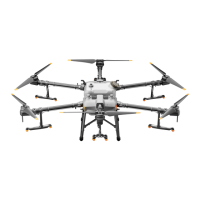6
©
2022 DJI All Rights Reserved.
AGRAS T30
Unmanned Aircraft Flight Manual
Flight Control Surfaces
Not applicable for multicopters.
Propulsion System
The propulsion system consists of motors, ESCs, and folding propellers, to provide stable and
powerful thrust.
Avionics
The avionics includes an aerial-electronics system, image transmission system, radar system, spraying
control board, and FPV module.
Flight Control and Navigation System
The ight control and navigation system built into the aircraft is integrated with modules such as the ight
controller, IMU, barometer, GNSS receiver, RTK module, and compass, providing stable and reliable
navigation and control. The dedicated industrial flight controller provides multiple flight modes and
operation modes for various applications. The GNSS+RTK dual-redundancy system is compatible with
GPS, GLONASS, BeiDou, and Galileo. The T30 also supports centimeter-level positioning when used
with the built-in onboard D-RTK antennas. Dual-antenna technology provides strong resistance against
magnetic interference.
Communications Equipment
The aircraft boasts two OcuSync antennas and DJI OcuSync Enterprise image transmission system,
offering a maximum transmission range of 7 km for communication with the remote controller.
FPV Module
Equipped with dual FPV cameras, the T30 provides clear front and rear views and allows you to check
the ight status without needing to turn the aircraft mid-ight. Furthermore, a bright searchlight doubles
the night vision capabilities of the aircraft, creating more nighttime operation possibilities.
Spherical Radar System (Detection and Obstacle Avoidance System)
Prole
The Spherical Perception Radar System, consisting of the Omnidirectional Digital Radar and Upward
Radar, works during day and night and is unaffected by light or dust. In an optimal operating
environment, the omnidirectional digital radar can predict the distance between the aircraft and the
vegetation or other surfaces in forward, backward, and downward directions to y at a constant distance
to ensure even spraying and terrain following capability. The radar system can detect obstacles in all
horizontal directions from 30 m away and from 15 m above in the upward direction. It effectively senses
the environment and helps to circumvent obstacles in both Route and A-B Route operation modes. In
addition, the radar module limits the descent speed of the aircraft according to the distance between the
aircraft and ground in order to provide a smooth landing.
The altitude stabilization and obstacle avoidance functions of the radar module are enabled by default
and can be disabled in the app. When enabled, the aircraft ies above the vegetation at a constant
spraying distance in Route, A-B Route, and Manual Plus operation modes. In Manual operation mode,

